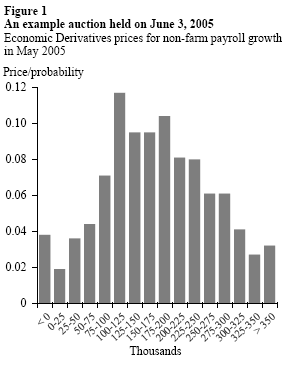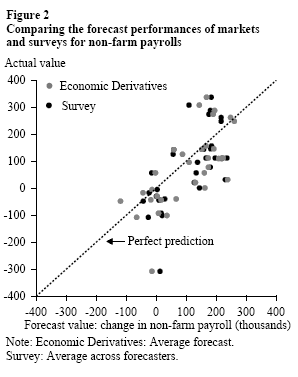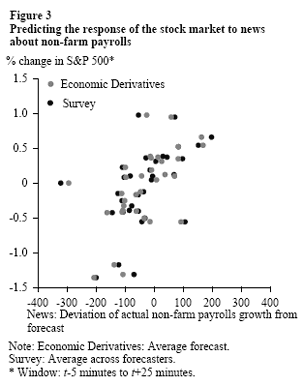Economic forecasters often look to the performance of futures markets to help predict such economic developments as movements in the price of oil and other commodities. In addition, relatively new financial market instruments, like TIPS (Treasury Inflation Protected Securities) help policymakers get a handle on the public’s inflation expectations.
- How derivatives markets for events work
- Using data from macro derivatives markets to make economic forecasts
- Conclusion
- References
Economic forecasters often look to the performance of futures markets to help predict such economic developments as movements in the price of oil and other commodities. In addition, relatively new financial market instruments, like TIPS (Treasury Inflation Protected Securities) help policymakers get a handle on the public’s inflation expectations.
In the last few years, derivatives markets involving bets on future economic events have emerged. In October 2002, Goldman Sachs and Deutsche Bank joined forces to form a market in what they call “Economic Derivatives.” This market allows investors to purchase instruments whose payoff is linked to growth in U.S. non-farm payrolls, retail sales, business confidence, and initial unemployment claims, as well as the Euro-area harmonized CPI. More recently, other U.S.-based markets have been created for GDP and the international trade balance, and plans are under way for instruments on the U.S. CPI.
For investors, these markets help hedge their portfolios against the uncertainties of economic outcomes. For forecasters and policymakers, these markets help pull together the best guesses of market participants, and thereby provide an informed consensus on how economic developments will unfold. This Economic Letter summarizes research by Gürkaynak and Wolfers (2005), which examines how these markets work and how useful they may be for economic predictions.
How derivatives markets for events work
In the Economic Derivatives market, a trader might purchase an instrument that pays $1 if the next employment report shows monthly growth in non-farm payrolls of between 100,000 and 125,000 jobs. The transaction is structured so that the payoff is binary—either $1 if you are correct, or nothing if you are not; hence, these are called “binary options.” Similarly, a trader can decide to purchase an instrument that pays $1 if employment grows by 125,000 to 150,000 jobs. Indeed, around a dozen such options are typically offered, thereby allowing traders to take positions on the particular outcomes that they regard as most likely. Traders also have the option of selling (or going “short”) on any outcomes that they think are particularly unlikely.
These options are traded in an auction that typically lasts for about an hour and which occurs either on the morning before the data release, or a few days before. As such, this market allows traders to hedge their portfolios so that they are not exposed to the particular risk—typically called “event risk”—that arises due to unexpected economic announcements causing sharp changes in the value of stocks and bonds.
A particularly interesting feature of this market is the mechanism used to match willing buyers with sellers. This market uses a pari-mutuel system, which is quite uncommon in financial markets, but much more common in horse racing. In the racing context, punters bet on their favorite horse, and all the money bet is put into a central pot; when the race is run, the house simply divides the money from this central pot among those who bet on the winning horse (with those who purchased more tickets receiving a proportionately larger share of the pot). In the Economic Derivatives context, the mechanism is similar, but instead of betting on a favorite horse, traders purchase tickets in their preferred economic outcome. An interesting feature of this mechanism is that the return to selecting the winning outcome is not known until all trades have been executed, although indicative estimates can be shown during the auction process.
 Figure 1 shows the final prices from a specific auction in which traders took positions on the number of jobs created in May 2005. We see that traders were willing to pay 11.7 cents for the option paying $1 if payroll growth was indeed between 100,000 and 125,000 jobs. As such, it seems reasonable to infer that this particular outcome had about an 11.7% probability of occurring. Inferring probabilities from the prices of binary options has some intuitive appeal, and Wolfers and Zitzewitz (2006) argue that it has also proven to be quite accurate in many other prediction markets.
Figure 1 shows the final prices from a specific auction in which traders took positions on the number of jobs created in May 2005. We see that traders were willing to pay 11.7 cents for the option paying $1 if payroll growth was indeed between 100,000 and 125,000 jobs. As such, it seems reasonable to infer that this particular outcome had about an 11.7% probability of occurring. Inferring probabilities from the prices of binary options has some intuitive appeal, and Wolfers and Zitzewitz (2006) argue that it has also proven to be quite accurate in many other prediction markets.
Gürkaynak and Wolfers also explore the question of whether risk-aversion might lead to a risk-premium, concluding that the evidence so far suggests that the relevant adjustment is sufficiently small that we can essentially ignore risk-adjustments.
Thus the prices on each of the outcomes shown in Figure 1 essentially provide a market-generated estimate of the full probability distribution of different outcomes. If the market is reasonably accurate, this distribution provides a set of forecasts of the likelihood of different outcomes that may be quite useful to forecasters and policymakers.
Using data from macro derivatives markets to make economic forecasts
The particular advantage of a market-generated forecast is that these prices reflect the joint wisdom of the many traders operating in this market, and not just the idiosyncratic views of a particular forecaster. Previous research tells us that aggregating forecasts from many forecasters typically produces a much more accurate forecast than simply following a preferred forecaster.
 We now have data from the first 153 of these Economic Derivatives auctions and have compared them with an alternative forecast aggregator: the survey of the expectations of financial market analysts taken on the Friday prior to the data release. Figure 2 shows this comparison for the most highly watched of our data series, monthly growth in non-farm payrolls. Specifically, we calculated the mean of the price distribution for each of the auctions in our sample, and the average forecast across forecasters from the Friday survey, and asked: Which better predicts the actual outcome? Figure 2 shows how similar the two competing sets of forecasts were. Even so, the Economic Derivatives forecasts were slightly (5%-10%) more accurate, although these differences were not statistically significant.
We now have data from the first 153 of these Economic Derivatives auctions and have compared them with an alternative forecast aggregator: the survey of the expectations of financial market analysts taken on the Friday prior to the data release. Figure 2 shows this comparison for the most highly watched of our data series, monthly growth in non-farm payrolls. Specifically, we calculated the mean of the price distribution for each of the auctions in our sample, and the average forecast across forecasters from the Friday survey, and asked: Which better predicts the actual outcome? Figure 2 shows how similar the two competing sets of forecasts were. Even so, the Economic Derivatives forecasts were slightly (5%-10%) more accurate, although these differences were not statistically significant.
Another way of analyzing these data is to ask: how should one weight these two sets of forecasts to arrive at an optimal prediction? A regression analysis is needed to answer this question, and here the results were less equivocal: once one knows the Economic Derivatives forecast, there is no useful information in the survey-based forecast. This is consistent with the efficient markets hypothesis, which suggests that market prices tend to incorporate all publicly available information—including the published forecasts of other forecasters.
We have also performed a similar comparison of the predictive ability of market- and survey-based forecasts for retail sales growth, business confidence, and initial unemployment claims, and this further analysis confirmed this general pattern: The Economic Derivatives forecast encompasses all of the information available in the survey-based forecast.
Another implication of the efficient markets hypothesis is that the stock market should only respond to unexpected developments. Thus, even if non-farm payrolls grew strongly in a particular month, if that growth was expected, its announcement should not lead to any changes in stock prices. This raises the question: What movements in non-farm payrolls are expected, and what are unexpected?
 The comparison of Economic Derivatives and survey-based forecasts provide two alternative baselines: We can compare actual outcomes to each of these forecasts, and ask which better predicts subsequent stock market movements. In order to isolate the specific stock market movements that were most likely to be driven by the announcement of economic news, we analyze the change in stock prices from 5 minutes before the announcement to a mere 25 minutes later. Figure 3 compares this stock market response to our two alternative measures of the unexpected component of non-farm payrolls. We find the measure based upon the Economic Derivatives data does a much better job in explaining the response of the stock market to economic news.
The comparison of Economic Derivatives and survey-based forecasts provide two alternative baselines: We can compare actual outcomes to each of these forecasts, and ask which better predicts subsequent stock market movements. In order to isolate the specific stock market movements that were most likely to be driven by the announcement of economic news, we analyze the change in stock prices from 5 minutes before the announcement to a mere 25 minutes later. Figure 3 compares this stock market response to our two alternative measures of the unexpected component of non-farm payrolls. We find the measure based upon the Economic Derivatives data does a much better job in explaining the response of the stock market to economic news.
We have extended this analysis in two further directions, examining both forecasts of other variables (business confidence, retail sales and initial unemployment claims), and the response of bond markets to economic news. In each case, we confirm our main conclusions: the Economic Derivatives market better predicts financial market responses to economic data than does the alternative survey-based measure.
Finally, there is an existing literature that suggests that economic forecasters tend to make systematic mistakes, in a manner consistent with some of the insights of behavioral economics. For instance, there is evidence that forecasters tend to stick with bad forecasts for too long and take insufficient account of recent data that should have led them to change their views. We performed similar tests on both of our forecast measures, finding some systematic evidence that the average survey-based forecast shows some of these problems. Interestingly, there is very little evidence that the market-based forecast displays these pathologies, although given our limited sample, this evidence should not be overstated.
Overall our analysis of the Economic Derivatives markets yielded quite convincing evidence that market-generated forecasts are very accurate and probably at least as accurate as any other form of forecast. This finding makes economic forecasting a very simple exercise for most of us: Rather than work through a complicated model of the economy, it is more accurate (and surely quicker!) simply to look to the prices in economic derivatives markets to assess the likelihood of various outcomes.
The underlying logic of these markets may eventually prove to be quite persuasive, and other research (Wolfers and Zitzewitz, 2004) has shown that analogous prediction markets have similar power in predicting outcomes as diverse as elections, baseball games, and movie successes. Ongoing research is examining the extent to which prediction markets may be harnessed to forecast outcomes of direct interest to both businesses and public policymakers. The intuition is simply that markets can make the wisdom of many of us easily accessible to all of us.
Justin Wolfers
Assistant Professor, University of Pennsylvania,
and Visiting Scholar, FRBSF
Gürkaynak, Refet, and Justin Wolfers. 2005. “Macroeconomic Derivatives: An Initial Analysis of Market-based Macro Forecasts, Uncertainty, and Risk.” FRBSF Working Paper 2005-26, and forthcoming in NBER International Seminar on Macroeconomics 2005, MIT Press.
Wolfers, Justin, and Eric Zitzewitz. 2004. “Prediction Markets.” Journal of Economic Perspectives 18(2) pp. 107-126.
Wolfers, Justin, and Eric Zitzewitz. 2006. “Interpreting Prediction Market Prices as Probabilities.” FRBSF Working Paper 2006-11.
Opinions expressed in FRBSF Economic Letter do not necessarily reflect the views of the management of the Federal Reserve Bank of San Francisco or of the Board of Governors of the Federal Reserve System. This publication is edited by Anita Todd and Karen Barnes. Permission to reprint portions of articles or whole articles must be obtained in writing. Please send editorial comments and requests for reprint permission to research.library@sf.frb.org